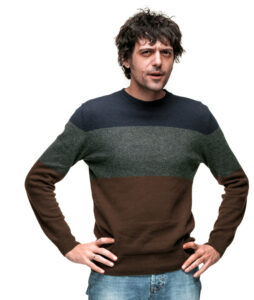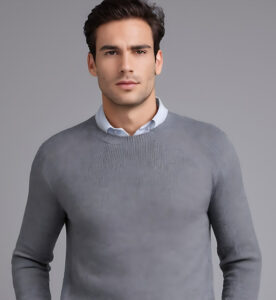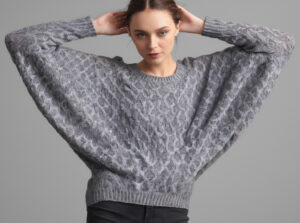A sweater, also known as a jumper, pullover, or jersey, is a knitted garment typically worn over the upper body. It is designed to provide warmth and comfort, making it a popular choice for cool or cold weather.
One of the key features of a sweater is its construction from knitted fabric, which can be made from a variety of materials such as wool, cotton, acrylic, or a blend of different fibers. The choice of material affects the sweater’s warmth, texture, and overall feel. Wool, for example, is known for its excellent insulation properties, providing effective protection against the chill, while cotton offers a lighter and more breathable option suitable for milder climates.
Sweaters can be categorized into different styles based on their design and purpose. Crewneck sweaters have a rounded neckline and are one of the most common and versatile styles. V-neck sweaters have a V-shaped neckline, providing a more formal and stylish look. Turtleneck sweaters extend the neckline to cover the neck, providing additional warmth and a distinctive aesthetic. Cardigans, with their button-down front, offer a convenient option for layering and adjusting to varying temperatures.

In addition to their practicality, sweaters have become fashion staples and are available in a wide array of colors, patterns, and textures. From classic solid colors to bold stripes, intricate cable knits to cozy chunky sweaters, there is a style to suit every taste and occasion. Sweaters can be paired with various bottoms, such as jeans, skirts, or trousers, allowing for versatile and stylish outfit combinations. Beyond their functional and aesthetic qualities, sweaters often hold sentimental value. Hand-knit sweaters, in particular, may carry the personal touch of the person who created them, making them cherished items passed down through generations or given as thoughtful gifts.
Whether worn for warmth, style, or both, the sweater has secured its place as a timeless and essential piece of clothing, adapting to changing fashion trends while remaining a reliable and comforting garment for individuals worldwide.
History of Sweater
The sweater, a cozy and versatile garment that graces wardrobes around the world, has a rich history rooted in practicality and comfort. Its evolution over the centuries reflects not only changes in fashion but also shifts in societal norms and lifestyles.
The origins of the sweater can be traced back to the 15th century in the Channel Islands, located in the English Channel. Fishermen, facing the harsh and unpredictable weather of the North Atlantic, needed a garment that could provide warmth and protection while allowing for ease of movement. The solution came in the form of a tightly-knit, woolen pullover known as the “jersey.” This simple garment featured a tight weave that effectively blocked wind and retained body heat, making it an essential piece for seafaring communities.
The jersey gained popularity beyond the fishing communities and eventually caught the attention of British aristocracy in the 19th century. Its practicality, coupled with a growing interest in outdoor activities, led to the adoption of the sweater as a fashionable and functional garment. By the early 20th century, the sweater had become a staple in both men’s and women’s wardrobes.
One iconic moment in the history of the sweater occurred during the 1920s when Coco Chanel, a pioneering figure in fashion, introduced the concept of “chic casual” by incorporating sweaters into her collections. This move elevated the status of the sweater from a utilitarian garment to a symbol of style and sophistication.
During the mid-20th century, the sweater underwent further transformations in terms of design and materials. The introduction of synthetic fibers and innovative knitting techniques allowed for a broader range of styles and textures. From chunky cable-knits to lightweight cashmere, sweaters became available in various fabrics, catering to different tastes and climates.
The cultural impact of the sweater reached new heights in the latter part of the 20th century and into the 21st century. Sweaters became associated with holiday traditions, from the iconic “ugly sweater” parties to cozy family gatherings around the fireplace. The garment became not only a functional necessity but also a symbol of warmth, comfort, and togetherness.
Today, the sweater continues to be a wardrobe essential, offering endless possibilities in terms of style, color, and texture. From classic crewnecks to trendy oversized designs, the sweater remains a versatile and timeless piece that transcends generations. Whether worn for practical warmth or as a fashion statement, the sweater’s enduring appeal speaks to its remarkable journey from the humble fishing jersey to a global symbol of comfort and style.
Types of Sweater
Sweaters come in various styles, each offering a different look, level of warmth, and versatility. Here are some common types of sweaters, along with their characteristics:
Crewneck Sweater:
Material: Typically made from cotton, wool, cashmere, or a blend. Provides a comfortable and breathable fit.
Styles: Can range from slim-fit to oversized, making it suitable for both casual and more polished looks.
Patterns: Common patterns include solid colors, stripes, or simple geometric designs.

V-Neck Sweater:
Material: Often crafted from materials like merino wool, cotton, or cashmere for a balance of comfort and style.
Versatility: Ideal for layering over collared shirts or dresses. Can be dressed up or down depending on the occasion.
Patterns: Available in various patterns, including solid colors, argyle, or subtle textures.

Turtleneck Sweater:
Material: Frequently made from wool, cashmere, or a blend for added warmth. Offers a luxurious and soft feel against the skin.
Styling: Works well with both casual and formal attire. Can be paired with skirts, trousers, or jeans.
Variations: Some turtlenecks have a foldable collar, allowing for versatile styling options.

Cardigan:
Closure Types: Available with buttons, zippers, or an open-front design. Allows for easy adjustment and styling.
Layering Piece: Serves as a versatile layering piece, perfect for transitioning between seasons.
Styles: Ranges from chunky knit cardigans for a cozy look to lightweight options for a more polished appearance.

Pullover Sweater:
Necklines: Comes in various necklines, including crewneck, V-neck, and turtleneck. Offers flexibility in styling.
Fit: Pullovers can have a relaxed, fitted, or oversized fit, catering to different preferences.
Texture: Knit patterns, such as cables or ribbing, add texture and visual interest to pullover sweaters.

Mock Neck Sweater:
Modern Appeal: Provides a contemporary and sleek look with a shorter standing collar.
Versatility: Can be worn casually with jeans or dressed up with tailored trousers for a sophisticated ensemble.
Material: Commonly made from cotton, wool, or synthetic blends for a comfortable and breathable feel.

Cable Knit Sweater:
Texture: The cable knit pattern adds depth and a classic touch. Provides a cozy and comforting feel.
Warmth: Known for its insulating properties, making it an excellent choice for colder weather.
Styles: Cable knit sweaters come in various styles, from chunky fisherman sweaters to more refined options.

Hoodie:
Casual Comfort: A go-to choice for a laid-back, sporty, or athleisure-inspired look.
Practicality: The hood provides added warmth, and kangaroo pockets offer convenience.
Materials: Available in fleece, cotton, or performance fabrics for different levels of warmth and comfort.

Off-the-Shoulder Sweater:
Feminine Touch: The off-the-shoulder design adds a flirty and feminine element.
Styling: Can be paired with high-waisted skirts, jeans, or leggings for various occasions.
Material: Often made from soft and lightweight materials for a comfortable fit.

Wrap Sweater:
Adjustable Fit: The wrap and tie design allows for a customizable and flattering fit.
Asymmetry: Offers a stylish and sometimes asymmetrical look, adding visual interest.
Versatility: Suitable for both casual and more dressed-up outfits, depending on the material and styling.

Tunic Sweater:
Length: Longer length provides coverage and allows for versatile styling, such as pairing with leggings or skinny jeans.
Comfort: Tunic sweaters often prioritize comfort, making them ideal for relaxed and laid-back occasions.
Patterns: Can feature simple patterns, stripes, or textured knits.

Fisherman Sweater:
Heritage Design: Inspired by traditional Irish fishing sweaters, known for their durability and timeless appeal.
Warmth: Offers substantial warmth, making it suitable for colder climates.
Texture: The cable knit pattern enhances the visual appeal and adds a rustic touch.

Cashmere Sweater:
Luxurious Material: Crafted from high-quality cashmere wool, providing a soft and luxurious feel.
Lightweight: Despite its warmth, cashmere is lightweight, making it an excellent choice for layering.
Elegance: Cashmere sweaters often exude a sense of elegance and refinement.

Fair Isle Sweater:
Traditional Pattern: Features a distinctive Fair Isle pattern with intricate designs and multiple colors.
Seasonal Appeal: Popular during the winter season, adding a festive and cozy vibe.
Versatility: Can be dressed up with skirts or down with jeans, offering a balance between traditional and contemporary styles.
Batwing Sweater:
Modern Silhouette: Characterized by wide, loose sleeves that taper at the cuffs, creating a contemporary look.
Comfort: Offers a relaxed and comfortable fit, perfect for casual and laid-back occasions.
Styling: Pair with fitted bottoms to balance the loose silhouette and create a stylish contrast.\

Boatneck Sweater:
Wide Neckline: The wide, horizontal neckline sits near the collarbones, providing a flattering and elegant look.
Shoulder Emphasis: Offers a slightly wider shoulder appearance, enhancing the overall silhouette.
Versatility: Can be dressed up or down, making it suitable for various occasions.

Bell Sleeve Sweater:
Feminine Detail: Sleeves flare out, resembling the shape of a bell, adding a touch of femininity.
Styling: Creates a stylish and trendy element, making it suitable for fashion-forward looks.
Materials: Can be made from various materials, including lightweight knits or more substantial fabrics for different seasons.

Crop Sweater:
Length: Shorter length, often ending above the natural waist, offering a modern and youthful aesthetic.
Styling: Ideal for showcasing high-waisted bottoms, such as skirts, pants, or jeans.
Casual or Dressy: Depending on the design and material, crop sweaters can be worn casually or dressed up for a chic look.
Shawl Collar Sweater:
Wide Collar: The wide, turned-over collar resembles a shawl, providing extra warmth and a sophisticated look.
Styling: Ideal for creating polished and refined outfits. Can be paired with trousers or skirts for a professional ensemble.
Materials: Often made from thicker knits or wool for a cozy and substantial feel.

Poncho Sweater:
Flowing Silhouette: Loose and flowing silhouette, resembling a poncho, adds a bohemian or casual-chic style.
Layering Piece: Can be used as a stylish layering piece over other tops. Ideal for a relaxed and effortless look.
Materials: Range from lightweight fabrics for transitional seasons to chunkier knits for colder weather.
These details provide a comprehensive overview of each type of sweater, helping you understand their unique characteristics, styling possibilities, and the materials commonly used in their construction. When selecting a sweater, consider your personal style, the occasion, and the desired level of comfort and warmth.
